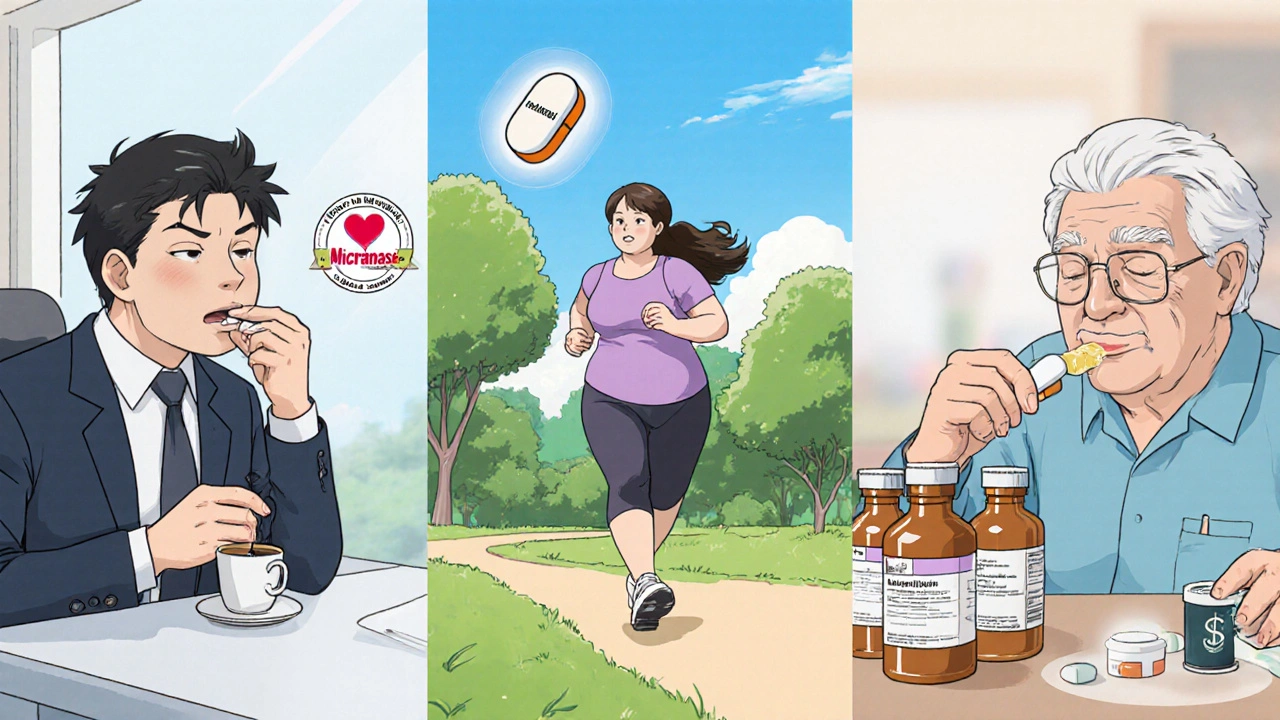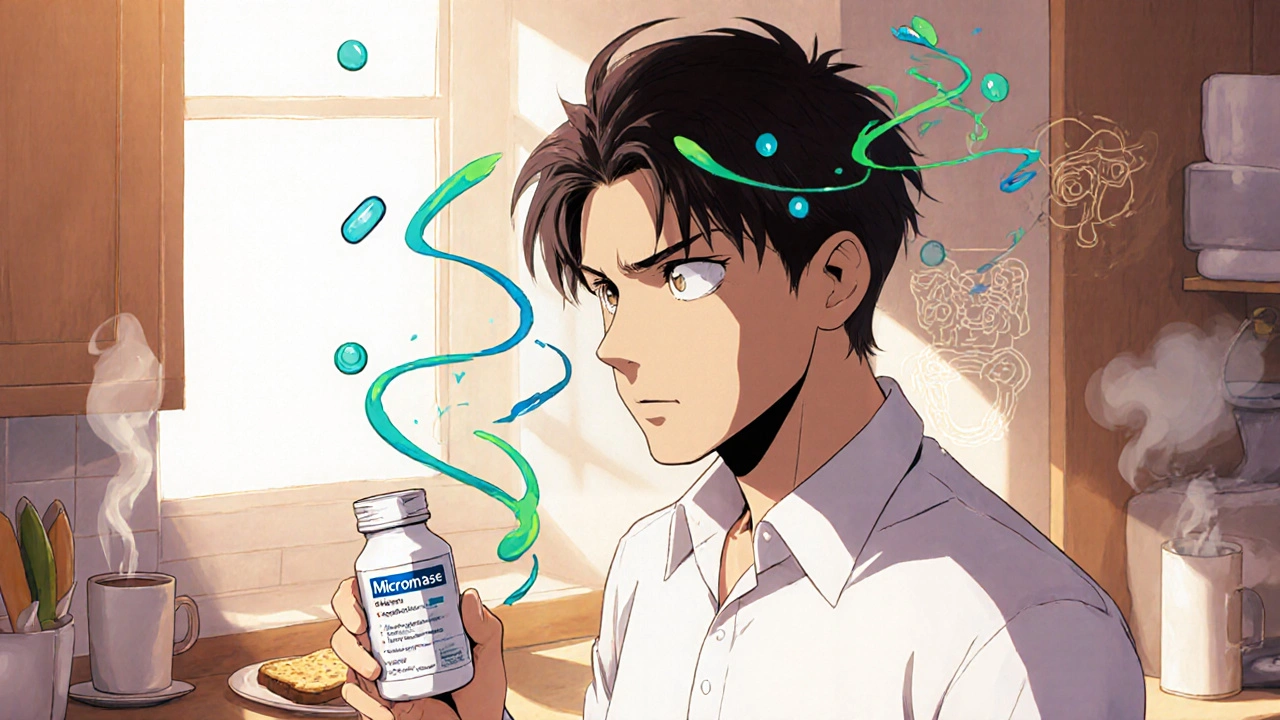When doctors prescribe a pill to lower blood sugar, the choice often feels like a gamble. Micronase is one of those bets - a sulfonylurea that’s been around for decades, but newer options keep popping up. This guide breaks down Micronase (glyburide) side‑by‑side with the most common alternatives, so you can see which drug matches your health goals, lifestyle, and safety concerns.
What Is Micronase (Glyburide)?
Micronase is the brand name for glyburide, a second‑generation sulfonylurea oral hypoglycemic agent. It works by prompting the pancreas to release more insulin, helping lower blood glucose after meals. Approved by the FDA in 1973, Micronase is usually taken once or twice daily with breakfast and dinner.
How Micronase Works Inside the Body
- Targets the beta cells of the pancreas, closing ATP‑sensitive potassium channels.
- Triggers a calcium influx that sparks insulin release.
- Provides a rapid glucose‑lowering effect that peaks in 2‑4 hours and lasts up to 12 hours.
Because it relies on the pancreas still being able to produce insulin, Micronase isn’t suitable for type 1 diabetes or advanced type 2 where beta‑cell function has collapsed.
Why Look at Alternatives?
Micronase does the job for many, but it carries a few drawbacks that newer drugs aim to fix:
- Risk of hypoglycemia - especially in older adults or those with irregular eating patterns.
- Weight gain - sulfonylureas can add a few pounds over time.
- Drug interactions - many antibiotics, antifungals, and certain heart meds can amplify its effect.
If any of these concerns ring a bell, consider one of the alternatives below.
Common Alternatives to Micronase
Below is a quick snapshot of the most frequently prescribed options, grouped by drug class.
- Glipizide - another sulfonylurea, slightly shorter acting.
- Glimepiride - the longest‑acting sulfonylurea on the market.
- Metformin - a biguanide that improves insulin sensitivity; first‑line for type 2 diabetes.
- Sitagliptin - a DPP‑4 inhibitor that boosts endogenous incretin hormones.
- Pioglitazone - a thiazolidinedione that enhances peripheral glucose uptake.
- Insulin glargine - a long‑acting basal insulin for people who need tighter control.
Side‑by‑Side Comparison Table
| Drug | Class | Typical Dosage | HbA1c Reduction | Weight Effect | Hypoglycemia Risk | Key Advantages |
|---|---|---|---|---|---|---|
| Micronase (glyburide) | Sulfonylurea | 2.5‑10 mg daily | 0.8‑1.2 % | +1‑2 kg | Medium‑High | Low cost, once‑ or twice‑daily dosing |
| Glipizide | Sulfonylurea | 2.5‑10 mg daily | 0.6‑1.0 % | ±0 kg | Medium | Shorter half‑life reduces overnight lows |
| Glimepiride | Sulfonylurea | 1‑4 mg daily | 0.9‑1.3 % | +0.5‑1 kg | Medium‑High | Once‑daily dosing, strong glucose lower |
| Metformin | Biguanide | 500‑2000 mg daily split | 0.7‑1.0 % | -1‑3 kg | Low | Weight loss, cardiovascular benefits, cheap |
| Sitagliptin | DPP‑4 inhibitor | 100 mg daily | 0.5‑0.8 % | ±0 kg | Low | Low hypoglycemia, once‑daily, works well with other meds |
| Pioglitazone | Thiazolidinedione | 15‑45 mg daily | 0.6‑1.0 % | +1‑2 kg | Low‑Medium | Improves insulin sensitivity, reduces liver fat |
| Insulin glargine | Long‑acting insulin | Varies; usually 0.1‑0.2 U/kg daily | 1.0‑1.5 % | ±0 kg | Medium (dose‑dependent) | Most potent for lowering HbA1c, flexible dosing |
How to Choose the Right Option for You
Picking a diabetes pill isn’t a one‑size‑fits‑all decision. Use the following checklist to line up the drug with your personal circumstances:
- Kidney function - Metformin and sulfonylureas need dose adjustments if eGFR drops below 30 mL/min.
- Risk of hypoglycemia - If you’re prone to low blood sugar (elderly, erratic meals), steer toward metformin, sitagliptin, or low‑dose glipizide.
- Weight considerations - Metformin often promotes modest weight loss; sulfonylureas can add weight.
- Cost & insurance coverage - Generic sulfonylureas and metformin are usually cheapest, while DPP‑4 inhibitors and newer insulins can cost significantly more.
- Comorbidities - If you have heart failure, pioglitazone may be contraindicated; if you have liver disease, insulin may be safer.
Talk to your clinician about these factors. A lab panel (HbA1c, fasting glucose, liver enzymes, kidney function) will help fine‑tune the dosage.
Potential Side Effects and How to Manage Them
Every drug listed above has a safety profile you should know.
- Micronase: hypoglycemia, weight gain, rare skin rash.
- Glipizide: similar hypoglycemia risk but shorter duration, mild nausea.
- Glimepiride: stronger glucose drop, higher chance of low blood sugar at night.
- Metformin: gastrointestinal upset (diarrhea, bloating), rarely lactic acidosis if kidneys fail.
- Sitagliptin: usually well‑tolerated; rare pancreatitis.
- Pioglitazone: fluid retention, possible increased fracture risk, and a debated link to bladder cancer.
- Insulin glargine: dose‑dependent hypoglycemia, local injection site reactions.
If you notice any alarming symptom-persistent nausea, unexplained swelling, or episodes of shakiness-contact your healthcare provider promptly.

Real‑World Scenarios
Case 1: Busy professional, modest HbA1c (7.5 %). He wants a pill he can take with breakfast and dinner, low cost, and minimal daily monitoring. Micronase or glipizide fits, but because he sometimes skips lunch, glipizide’s shorter action reduces overnight lows.
Case 2: Over‑weight middle‑aged woman with hypertension. She needs a drug that won’t add weight and may improve cardiovascular risk. Metformin is first‑line; adding sitagliptin later can boost control without weight gain.
Case 3: Elderly patient on multiple meds, occasional appetite loss. Hypoglycemia is a big concern. A DPP‑4 inhibitor like sitagliptin, possibly combined with a low dose of metformin, offers safe glucose control.
Bottom Line: Is Micronase Still Worth It?
If you’re already stable on Micronase, there’s no urgent need to switch-especially if cost is tight. However, if you’ve experienced low blood sugar, weight gain, or have kidney issues, exploring one of the alternatives could improve quality of life.
Frequently Asked Questions
What makes Micronase different from other sulfonylureas?
Micronase (glyburide) has a longer half‑life than glipizide, which means it stays active overnight and can cause more frequent hypoglycemia. It’s also one of the cheaper options, making it popular for patients on a tight budget.
Can I take Micronase with Metformin?
Yes, many clinicians pair a sulfonylurea with metformin to get the benefits of both insulin release and improved insulin sensitivity. The combination can lower HbA1c by up to 2 % but requires careful monitoring for low blood sugar.
Is Micronase safe for people with kidney disease?
Sulfonylureas, including Micronase, are cleared partly by the kidneys, so dose reduction is needed when eGFR falls below 30 mL/min. In severe kidney impairment, doctors often switch to drugs like sitagliptin or insulin.
Why do some patients gain weight on Micronase?
Sulfonylureas stimulate insulin release, and higher insulin levels promote fat storage. Additionally, lower blood sugar can increase appetite in some people, leading to extra calories.
What should I do if I experience a hypoglycemic episode?
Consume 15‑20 g of fast‑acting carbohydrate-like glucose tablets, juice, or regular soda-followed by a snack containing protein. Check your blood sugar after 15 minutes; repeat if still low. Carry emergency glucagon if you have severe episodes.






